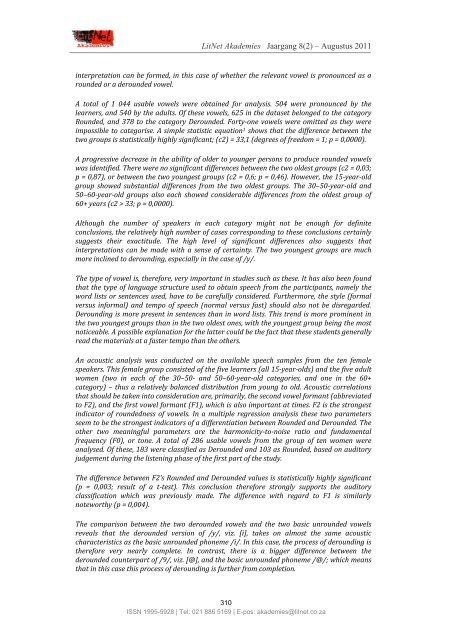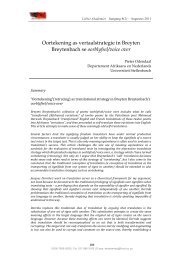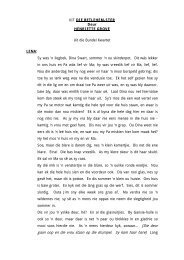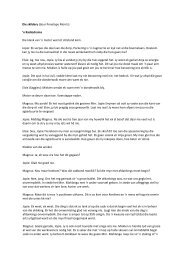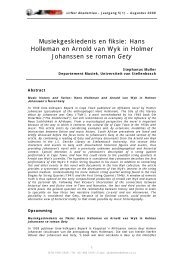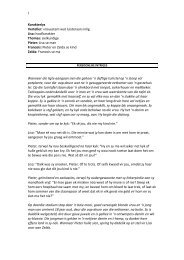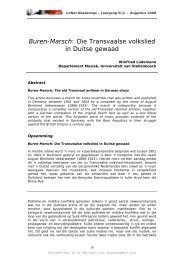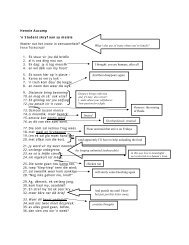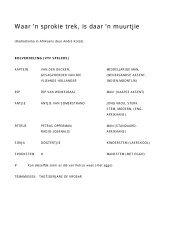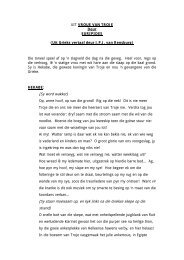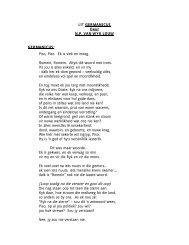Jaargang 8, nommer 2 – Augustus 2011 - LitNet
Jaargang 8, nommer 2 – Augustus 2011 - LitNet
Jaargang 8, nommer 2 – Augustus 2011 - LitNet
You also want an ePaper? Increase the reach of your titles
YUMPU automatically turns print PDFs into web optimized ePapers that Google loves.
<strong>LitNet</strong> Akademies <strong>Jaargang</strong> 8(2) <strong>–</strong> <strong>Augustus</strong> <strong>2011</strong><br />
interpretation can be formed, in this case of whether the relevant vowel is pronounced as a<br />
rounded or a derounded vowel.<br />
A total of 1 044 usable vowels were obtained for analysis. 504 were pronounced by the<br />
learners, and 540 by the adults. Of these vowels, 625 in the dataset belonged to the category<br />
Rounded, and 378 to the category Derounded. Fortyone vowels were omitted as they were<br />
impossible to categorise. A simple statistic equation 1 shows that the difference between the<br />
two groups is statistically highly significant; (c2) = 33,1 (degrees of freedom = 1; p = 0,0000).<br />
A progressive decrease in the ability of older to younger persons to produce rounded vowels<br />
was identified. There were no significant differences between the two oldest groups (c2 = 0,03;<br />
p = 0,87), or between the two youngest groups (c2 = 0,6; p = 0,46). However, the 15yearold<br />
group showed substantial differences from the two oldest groups. The 30<strong>–</strong>50yearold and<br />
50<strong>–</strong>60yearold groups also each showed considerable differences from the oldest group of<br />
60+ years (c2 > 33; p = 0,0000).<br />
Although the number of speakers in each category might not be enough for definite<br />
conclusions, the relatively high number of cases corresponding to these conclusions certainly<br />
suggests their exactitude. The high level of significant differences also suggests that<br />
interpretations can be made with a sense of certainty. The two youngest groups are much<br />
more inclined to derounding, especially in the case of /y/.<br />
The type of vowel is, therefore, very important in studies such as these. It has also been found<br />
that the type of language structure used to obtain speech from the participants, namely the<br />
word lists or sentences used, have to be carefully considered. Furthermore, the style (formal<br />
versus informal) and tempo of speech (normal versus fast) should also not be disregarded.<br />
Derounding is more present in sentences than in word lists. This trend is more prominent in<br />
the two youngest groups than in the two oldest ones, with the youngest group being the most<br />
noticeable. A possible explanation for the latter could be the fact that these students generally<br />
read the materials at a faster tempo than the others.<br />
An acoustic analysis was conducted on the available speech samples from the ten female<br />
speakers. This female group consisted of the five learners (all 15yearolds) and the five adult<br />
women (two in each of the 30<strong>–</strong>50 and 50<strong>–</strong>60yearold categories, and one in the 60+<br />
category) <strong>–</strong> thus a relatively balanced distribution from young to old. Acoustic correlations<br />
that should be taken into consideration are, primarily, the second vowel formant (abbreviated<br />
to F2), and the first vowel formant (F1), which is also important at times. F2 is the strongest<br />
indicator of roundedness of vowels. In a multiple regression analysis these two parameters<br />
seem to be the strongest indicators of a differentiation between Rounded and Derounded. The<br />
other two meaningful parameters are the harmonicitytonoise ratio and fundamental<br />
frequency (F0), or tone. A total of 286 usable vowels from the group of ten women were<br />
analysed. Of these, 183 were classified as Derounded and 103 as Rounded, based on auditory<br />
judgement during the listening phase of the first part of the study.<br />
The difference between F2’s Rounded and Derounded values is statistically highly significant<br />
(p = 0,003; result of a ttest). This conclusion therefore strongly supports the auditory<br />
classification which was previously made. The difference with regard to F1 is similarly<br />
noteworthy (p = 0,004).<br />
The comparison between the two derounded vowels and the two basic unrounded vowels<br />
reveals that the derounded version of /y/, viz. [i], takes on almost the same acoustic<br />
characteristics as the basic unrounded phoneme /i/. In this case, the process of derounding is<br />
therefore very nearly complete. In contrast, there is a bigger difference between the<br />
derounded counterpart of /9/, viz. [@], and the basic unrounded phoneme /@/; which means<br />
that in this case this process of derounding is further from completion.<br />
310<br />
ISSN 1995-5928 | Tel: 021 886 5169 | E-pos: akademies@litnet.co.za


